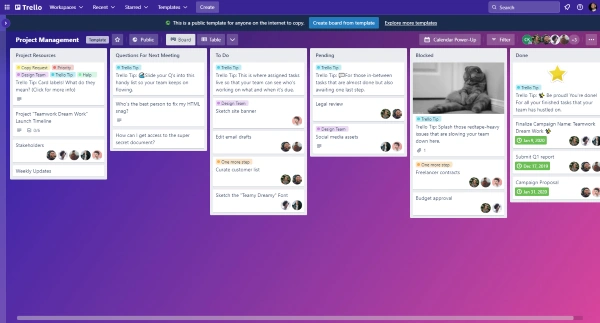Trello For Architects - A Comprehensive Guide
Architects are tasked with the complex and multifaceted responsibility of designing buildings. These have to be aesthetically pleasing but also functional, safe, and environmentally sustainable.
Managing architectural projects can be daunting, as it involves coordinating various stakeholders, keeping track of design iterations, meeting deadlines, and adhering to budgets.
Architects are increasingly turning to project management tools like Trello to address these challenges. This popular online project management tool offers architects a powerful platform to streamline workflows, enhance communication, and ultimately achieve exceptional results.
This comprehensive guide will explore how architects can leverage Trello to streamline their project management processes, enhance collaboration, and ultimately deliver successful architectural projects.
How Trello Can Help Architects

Trello is a visual project management tool that allows architects to organize their tasks and projects in a way that is intuitive and easy to understand. Here are all the ways architects can get value from it.
Organizing Projects and Tasks:
Trello's intuitive board and card system simplifies project management, allowing architects to:
- Create boards: Dedicate a board to each project, visualizing its phases, tasks, and deadlines.
- Utilize cards: Represent individual tasks, adding details, checklists, and due dates.
- Implement lists: Categorize cards into phases like "Design Development," "Construction Documents," and "Review."
- Prioritize tasks: Use colored labels to indicate priority levels for efficient task management.
- Track progress: Monitor progress as cards move through different lists, keeping stakeholders informed.
Enhanced Collaboration and Communication:
Trello fosters a collaborative environment, enabling architects to:
- Assign tasks: Delegate tasks to team members, ensuring accountability and clear ownership.
- Add comments and attachments: Discuss ideas, provide feedback, and share relevant files directly on task cards.
- Tag team members: Mention specific individuals in the comments for targeted communication and updates.
- Utilize checklists and deadlines: Collaborate on checklists and set deadlines for each task, ensuring coordinated progress.
- Integrate with other tools: Connect Trello with platforms like Slack, Dropbox, and Google Drive to streamline workflow.
Streamlining Design Processes and Document Management:
Trello offers valuable features for architects to:
- Store design assets: Upload drawings, renderings, and other design files directly to cards for easy access.
- Organize reference materials: Create boards for inspiration, mood boards, and technical references.
- Share designs with clients: Use Trello to share designs with clients, gather feedback, and iterate effectively.
- Facilitate brainstorming and discussions: Utilize boards to capture ideas, sketch concepts, and collaborate on design solutions.
- Track design revisions: Keep track of design revisions with detailed comments, versions, and attachments on cards.
Boosting Efficiency and Productivity:
Trello helps architects:
- Reduce email clutter: Use cards and comments for collaborative discussions instead of lengthy email chains.
- Automate repetitive processes: Utilize Trello Automation to automate tasks like assigning due dates and moving cards.
- Set reminders and notifications: Stay on top of deadlines and important tasks with timely alerts.
- Focus on value-added activities: By streamlining tasks and communication, architects can dedicate more time to creative design work.
- Improve team morale: Enhance team collaboration and communication, creating a positive and productive work environment.
Trello is also free to use, and it operates in any browser, making it a cost-effective solution for architects. It can be integrated with other tools, such as email, to keep all project-related communication in one place.
Using Trello for Architects
Setting up Trello for architects involves creating a team area where all team members can see the firm's projects. Once the team is set up, you can create boards for each project.
Each board can then have lists for different project stages such as “To Do”, “In Progress_,'”_ and “Done.” Cards can be added to these lists to represent individual tasks. You can also add due dates to cards to keep track of deadlines.
Trello also allows you to create custom fields for cards, which can be used to store additional information about each task.
This can include details such as the estimated time to complete the task, the person responsible for the task, or any other relevant information. Custom fields can be used to create a more detailed and comprehensive project plan.
Trello offers numerous advantages for architects, primarily in project organization, collaboration enhancement, workflow efficiency, accessibility, and integration with other tools.
Architects can create dedicated boards for each project, categorizing tasks, ideas, and resources. Tasks are managed using cards with due dates, descriptions, and checklists, assigned to team members, and tracked with color-coded labels.
The app also facilitates team communication through comments, file sharing, and a voting feature for task prioritization. Its visual boards help identify bottlenecks, and automation features save time on repetitive tasks.
If that wasn’t enough, architects can access Trello from any device, it supports remote collaboration and offline work.
Using Trello for Architect Project Management
Once Trello is set up, it can be used for project management in several ways. For example, you can use it to track the progress of each task and project and to identify any bottlenecks or delays. Not only that, it offers efficiency no matter how big or small your team is.
Trello for Different Architectural Needs:
The versatility of Trello allows it to adapt to various architectural needs:
- Solo architects: Organize projects, manage tasks, and easily track progress.
- Small firms: Collaborate seamlessly, share documents, and keep everyone informed.
- Large firms: Manage complex projects with multiple teams and stakeholders efficiently.
- Construction teams: Coordinate tasks, track progress, and share updates with architects.
- Clients: Get involved in the design process, provide feedback, and stay updated on progress.
Trello also allows you to assign tasks to specific team members, and to set due dates for tasks. This can help the project to stay on schedule.
Trello also has features for collaboration, such as comments and attachments. This can be useful for discussing tasks and ideas with your team and for sharing files and documents related to the project.
Trello also has features for communication, such as notifications and integrations with other tools. This helps keep your team informed about the status of the project and any changes that need to be made.
Power-Ups for Architects
Trello Power-Ups are essentially superpowers that your Trello board can have to make your boards more functional and powerful. They are essentially integrations between Trello and your other favorite tools, adding more functionality to your boards.
Here are a few Power-Ups that could be useful for architects:
- Google Drive Power-Up: This allows you to attach and display your files from Google Drive in a savvy way. It can be particularly useful for architects who need to share design files or other documents with their team.
- Swimlanes: This helps you to break your Trello board up and show only cards for a single member/label/etc in each grouping. It can be particularly useful for architects who need to visualize and prioritize their work more effectively.
- Voting Power-Up: This collects votes from your team, community, or customers on Trello cards and makes it simple to prioritize cards. It can be useful for architects who need to gather feedback or make decisions based on team input.
- Card Repeater Power-Up: This set tasks to recur daily, weekly, monthly, or yearly to save time. It can be a useful tool for architects who have recurring tasks or need to schedule regular meetings or reviews.
- Slack Power-Up: This helps to send Trello cards to Slack DMs and channels directly from Trello and get notifications about your cards within your Slack channels. It can be a valuable tool for architects who use Slack for team communication.
Remember, the best Trello Power-Ups can spruce up your Trello boards and add more functionality to them.


